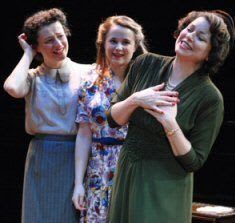Congratulations to all involved in this superb project. If ever there was a labour of love, this is it. Two writers have teamed up to recreate Chekhov's Three Sisters re-set amongst the Jewish community of Liverpool immediately after the Second World War.
However, that would not have been enough to ensure a high quality production. Another pairing, the Liverpool Everyman and Playhouse and Hampstead Theatre have joined together to co-produce an evening where seemingly no expense has been spared.
A high-quality primarily Jewish (although a sister or two and Finbar Lynch may well buck the trend) cast has been brought together under expert director, Lindsay Posner. For close to three hours, they set out to draw in and entertain their audiences.
Lucky visitors will undoubtedly be delighted to have the chance to enjoy Chekhov but also a beautifully judged portrait of Jewish life in what sixty years later has become another age.
In this context, the play could not have found a better first London home than Hampstead Theatre, set in the midst of a Jewish community whose members will recognise almost every character type and identify with many of them.
It is sincerely to be hoped that their second London home will be in the West End and subsequently some enterprising producer will consider taking the sisters to New York. The city is a goal for them but surely an obvious home for the play, with the largest Jewish community in the world.
The attention to detail is tremendous, and the first step was to take Chekhov's classic play and find a setting that matched the period leading up to the Russian Revolution, when Three Sisters was written and set.
It seems likely that Diane Samuels, who co-wrote the play with EastEnders' Tracy-Ann Oberman was the person who came up with the idea of locating it in Liverpool, just before the GIs went home in the late 1940s. The parallels are remarkable, making this a properly realised play in its own right, as well as a worthy tribute to its progenitor.
It seems best to describe this play on its own merits, relying on readers to know or research Chekhov for themselves.
The whole play takes place in the affluent Hope Street house of the Laskys, designed by Ruari Murchison in a cut down stage space. Unusually, the set is literally reversed at the interval, so that having spent an hour and a quarter looking at goings-on in the comfortable lounge, the remainder of the evening is spent focusing on the dining room, which had previously been in the background.
Into these spaces cram the three sisters and their brother Arnold, the latter looking uncannily like Anton Chekhov. In addition, an aunt and uncle, several American servicemen, and various in-laws and babes ensure that the space is fully occupied.
The first scene takes place on a day in 1946 that is simultaneously the 25th birthday of the youngest (Rita played by Samantha Robinson) and also the first yartzheit or anniversary of their father's death.
The celebration is inevitably muted but presents a good introduction to a close-knit family where even the ageing uncle and aunt, experienced actors Philip Voss and Jennie Stoller having great fun, feel very much at home.
The people who fit in least well are not the visitors from the United States but the actual and prospective in-laws. Elliot Levey is middle sister May's schoolteacher husband. He is a boring, good-natured, local man with a line in rather funny jokes.
Sadly, he is born to be cuckolded and, inevitably, Suzan Sylvester's May obliges, with the assistance of handsome US airman Vince Samuel, played by Finbar Lynch.
By way of contrast, the truly awful Cilla Black soundalike, Debbie whom you want to jump onto stage and strangle so good is Daisy Lewis's performance, is destined to take over the household. The third sister, Anna Francolini's Gertie seems born to be a spinster schoolteacher thriving on Chekhovian drudgery.
While the girls dream of a return to New York, which they left in the mid-1920s there is an alternative. This is the goal of Russell Bentley playing Rita's fiancé fated GI, Tush. He believes that a Jewish state will be founded in Palestine and wants to be there at its inception.
Through four acts, the writers combine an intricate look at the relationships within the family but never forget the world outside, with Mosley's riots and the push towards a new Israeli state featuring large. This adds rich flavour to the play and ensures that it stimulates from start to finish.
3 Sisters on Hope Street is beautifully acted by all concerned, with Suzan Sylvester possibly the pick of a very strong cast. It has enough power to move viewers to anger, despair and humour at different stages. This is a really superb evening's entertainment and comes highly recommended.
